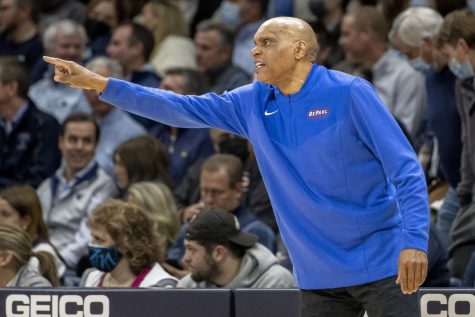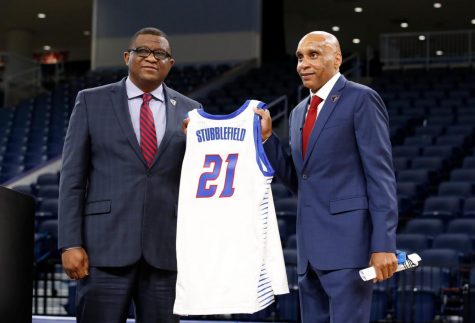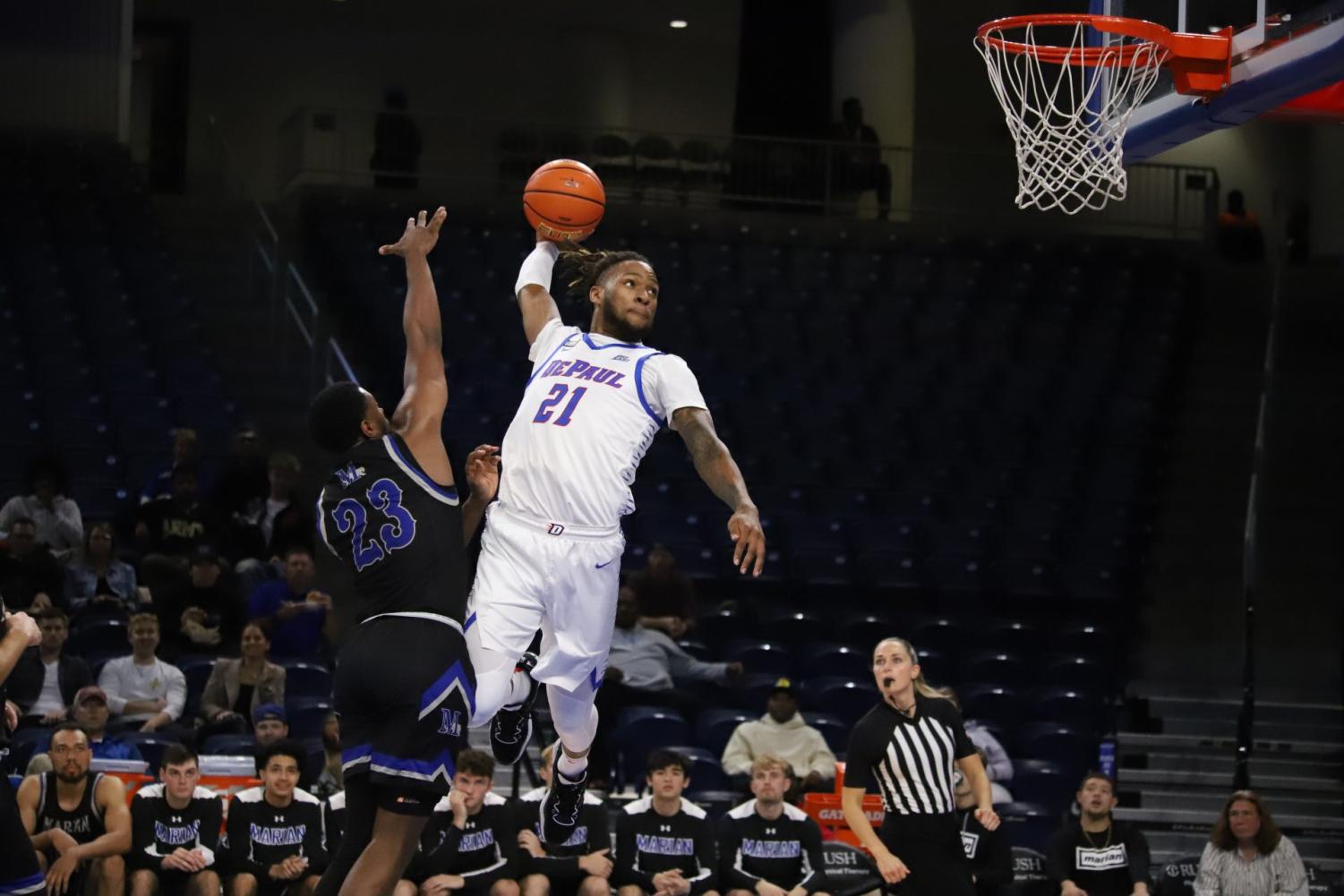State of the program: Do Peevy and Stubblefield have the resources needed to move men’s hoops forward?
November 7, 2022
It has been 6,807 days since the DePaul men’s basketball team has played in an NCAA tournament game.
After enjoying significant success from the late ‘70s through the ‘80s and ‘90s, with 16 NCAA tournament berths between 1976 and 2004, DePaul has undergone a dry spell. It has been 18 seasons since the Blue Demons last reached the big dance in 2004, when current DePaul freshman and highly touted recruit Zion Cruz had yet to be born.
So, what happened?
“The late ‘70s was a magical time for DePaul basketball under Ray Meyer,” said former Chicago Tribune sportswriter and current DePaul professor Fred Mitchell. “The timing was just perfect… A lot of people felt that DePaul basketball was bigger than the Bulls.”
In the era before ESPN, nationally broadcasted games through a partnership with WGN gave DePaul a rare spotlight. Mitchell says that this enabled the program to regularly attract top talent, both from within Chicago and other parts of the country.
When college basketball became a major product, with games televised nationally through network stations and ESPN, DePaul’s advantage was gone. In the mid ‘90s, they had joined Conference USA, which upped the ante in terms of competition for the Blue Demons. When DePaul joined the Big East in 2005, they began to regularly compete against schools with more resources than they had before.
“DePaul tried to play catch up in terms of recruiting and sustainability and coaching and all of the aspects that play into being a successful program,” Mitchell said. “When you have the Georgetown’s of the world recruiting the same players you are, you’re immediately at a disadvantage.”

Since joining the Big East, DePaul has finished with only two winning seasons, once in 2006-07 and again in 2018-19.
When DeWayne Peevy arrived at DePaul to take on the role of Athletic Director in August of 2020, a tall task stood in front of him. A year later, Peevy brought in Tony Stubblefield to lead the Blue Demons squad through a complete program rebuild. Now entering the duo’s second full season together, what progress has been made? What else must be done?
“I didn’t come in thinking I’m some miracle worker that I’m just going to do a couple of things here and there, and we’re going to just win,” Peevy said. “I really wanted to assess what are the issues… and I found that the budget was a main issue.”
Winning big in collegiate revenue sports demands funding. Peevy says when he came into his current role, the program had the 10th lowest budget of the 11 teams in the Big East. The athletic director believed that the best way to increase the team’s resources was to first garner non-financial support from the university, fans and alumni.
“Because we haven’t performed at a high level in a [long] time period, it’s been enough for people to be able to not realize what kind of impact basketball could have,” Peevy said.
Peevy began to try and show the DePaul community what a successful athletic program can do for the academics at a university. Throughout his first two years, the director has spoken in press conferences, at faculty council meetings and more on how things like an NCAA tournament berth directly impacts enrollment or immediately raises funds for the university as a whole.
“I talk a lot about athletics being the front porch of a university,” Peevy said. “A lot of people, the first thing they know about a school is its athletics program.”
When Peevy was hired, DePaul bottomed the Big East in terms of the university’s overall budget dedicated to athletics. The director says that around 6% of the school’s budget went to athletics, where the conference’s median was 9%. Since then, Peevy has successfully lobbied for budget increases resulting in tangible strides, like chartering flights for both the men’s and women’s teams to conference games and a regular practice for programs around the country.
While the department’s fundraising efforts are vital to the program’s rebuild, these things take time to translate to the court. In today’s game, coaches are given less time to find success, and fans demand concrete results.
“I think it takes time to build a program,” said head coach Tony Stubblefield, heading into his second season as the team’s architect. “It doesn’t happen overnight, and with that being said, I do realize the fans want instant gratification to keep things going in the right direction.”
Stubblefield’s team hit the court running in his first season with a meteoric 9-1 start last year, only to 6-15 over their remaining games to finish 15-16. Coming into year two, the acquired talent through the transfer portal and a touted freshman class gives Stubblefield an opportunity to build from the season prior and take a foundational step towards sustained success.
“I think you need to have a foundation of some freshman,” Stubblefield said. “You do need to go to a portal to help relieve some of that pressure and heavy lifting off some of the guys, and that’s why we brought in a guy like Mo Gibson and Caleb Murphy.”
Even with the added talent and increasing resources, DePaul’s unique position comes with its own difficulties in achieving success as a perennial power that other programs might not experience. As a private Catholic school in a major city, it exists in the shadow of Chicago’s professional sports scene. At Peevy’s old stomping grounds, the University of Kentucky, basketball is king. Lexington’s attention focuses on Rupp Arena any time the Wildcats play, a phenomenon that is likely impossible in Chicago.

Still, DePaul needs to assemble fan support best it can, and according to Peevy, filling Wintrust is the first step. Sizable crowds will help the Blue Demons win games.
“It’s hard [for players] mentally to play every game on the road in front of a packed house, and play neutral site games at home,” Peevy said.
Since moving into Wintrust after it opened in 2017, attendance for DePaul men’s basketball games ranks last in the Big East. This season, the athletic department is employing new strategies to get fans in the stands like free student admission, student meal vouchers to be used at concessions and added entertainment. Whether these incentives will bring fans in remains to be seen, but filling the arena is a crucial ingredient in growing DePaul’s national brand.
A successful rebuild is a complicated process with countless moving parts, many of which take years to come to fruition. Perhaps the most important factor, and one that doesn’t demand as much time as growing funds and resources, is winning.
“If you win, then you’re going to attract top talent,” Mitchell said. “And when you attract top talent, you’re going to do better in the conference and nationally, and you’ll just have sustained success, which is what all programs aspire to do.”
Coming into the 2022-23 season, few have picked DePaul to finish above the bottom of the Big East. Both Sports Illustrated and the Big East Preseason Coaches’ Poll set DePaul to finish last in the league, with CBS Sports predicting the Blue Demons to finish in the second to last spot.
Inside the program, optimism for the upcoming season is high. There is buzz from fans, and for Peevy, the low expectations for the team will have only put a chip on the players’ shoulders, but his goals for the team remain lofty.
“I think this group, their focus, they know that they’ve got to prove that we’re not the worst team in the Big East,” Peevy said. “My goal is to make the NCAA tournament… why am I in this if I don’t think we can finish above the middle of the pack?”
Tonight, DePaul has an opportunity to take an important step forward with an impressive showing in their opener with Loyola (MD). Though a rebuild is a long process and resources will likely continue to trickle in, the best thing Stubblefield and company can do right now is win with what they have.
“We have the tools and resources to be successful,” Stubblefield said. “There’s no excuses on this end… we have enough to get this thing turned around going in the right direction.”
